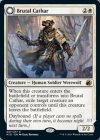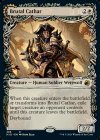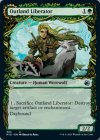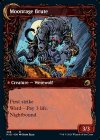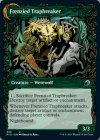Thank you thread for reminding me to put in
Emiel the Blessed into my list, I picked it up to be a signpost for the newly-supported blink archetype.
Back to Midnight Hunt, I was re-reading
Wtwlf123's always-thoughtful set (p)review for the set, and one thing that I really like about how he does these articles are the
ranking element. For a lesser writer, it'd be easy to consider the take-away sections listing the size of cube that he would factor inclusion in as reductive. But he takes the incredible effort as he goes through to provide context, to note which kinds of cubes may have a higher preference for certain cards/effects, etc. and I find his reasoning to be some of the most thoughtful. However, I was even more interested than usual when he laid out his ranking system like so:
I base my rankings not on what the “best” card is in a particular set (the “best” card in this set is probably Consider) but rather my ranking is based on: A) the average size of cube the card could realistically see play in, and B) the card’s likely tenure in the cube. When a stellar 2-power 1-drop comes out (one that’s one of the best ones available to it in its respective color) it’s going to bump out the worst card in slot, and it will likely have a relatively long stent in the cube. For example, if this is the #3 or #4 best red 2-power 1-drop, for example, and you want to play ~7 or more of them in your cube, that means a card like this Pit Fighter will be in the cube until they print 3 or 4 more 2-power 1-drops …in red …with upsides …that are better than this card, before it gets booted. And that’s simply going to take a long time to happen. Why? Because this card is good.
I love this explanation. The two-pronged approach to what the ranking of the card is not quite what he considers the "best" card, a metric he doesn't lay out but gives a very telling example of in the form of
Consider. For the audience he writes for, these metrics are solid, and I wouldn't recommend a change. It made me wonder, though, from my POV, what are the "best" cards in the set? If I were to try to do a "power ranking", what metrics would I use?
Typically, when making decisions in cube, I look towards the community consensus as the default to work off of. I feel no compulsion to match the average cube, but it's a helpful jumping off point to look at what
the most-played 2-drop creatures in green are when I notice a weakness in one on my list, and using data from Cube Cobra in this way is something I do obsessively. Again, I end up foraging my own path more often than not, but the community averages give me something to argue with when the forums are quiet.
But when I think about my own "power ranking", when I think about the headline cube card from an old set, it's not "the most popular", "the most powerful in slot", or "the least likely to get replaced with the next set's hotness", though these are all compelling. I think my power ranking would be based on:
1. To what extent does it enable new archetypes and/or bolster existing strategies?
2. If you pick it early, how and to what extent does it change your evaluation of other cards for the rest of the draft?
3. To what extent does it contribute to interesting (fair) gameplay?
With this, the first point, enabling new strategies, is certainly the most important to me. For example I’m super stoked for
Augur of Autumn and imagine it’ll last a long time in my cube, and nails point #3 in particular, and does ok with #2 by slightly nudging you to pick up creatures with different powers (more realistically, just to pick up a lot of creatures), but it’s pretty much in the same vein as other cards that are already in cube, and the redundancy she provides doesn’t help a deck get there that otherwise struggled to come together. She ranks in the middle of my 22 MID inclusions by these criteria, even though, yes, love her and expect her to have good staying power.
So with that context, here's my top 5 for
Innistrad Midnight Hunt, according to the above metrics:
 5. Intrepid Adversary
5. Intrepid Adversary
Finally, a cubable anthem? As they say on TikTok: let me explain.
Celestial Crusader is a card I’ve long-loved and was in cube for its first year of inception, around a decade ago now. I loved the combat trick part of it, but it cost one mana too much for the effect, only helped white creatures, and really didn’t want to attack with its peers. So back then, cards like
Glorious Anthem were better and then we got
Spear of Heliod (!) that added value on top of that.
But in the last 7 years or so, even the Spear has dropped off most cube lists. A dedicated anthem is simply not practical enough for its own slot, which is wild considering how tokens have become more and more ubiquitous. Creatures have become too powerful on their own to not need a third-party effect.
Benalish Marshal was the exact card I had been hoping for, but with untenable mana expectations.
Force of Virtue was close, but either way to pay the cost is too high.
Enter
Intrepid Adversary. It’s an on-curve lifelinking creature with a scalable anthem attached. If this creature only had the 4-mana 4/2 mode available, it would be worth serious consideration, but giving it a 6-mana overrun
and a 2-mana 3/1 lifelinking out makes this Adversary the most valuable of the cycle, sure, but also a big kick in the butt towards Wx tokens, aggressive strategies, and even most midrange decks. It’s an enabler, role-player, bomb, and a race-evener all in one.
tl;dr finally, a cubable anthem effect
 4. Moonveil Regent
4. Moonveil Regent
A card like this is where this approach to ranking cube cards for a set is more compelling to me. Would I play Moonveil Regent if I had a much smaller cube? Probably couldn’t justify it under 500 cards, to be honest. Is it in the top half of my red 4-drops by most metrics? Not quite. But was there a card with this kind of effect before that was competitive with the rest of my cube list? No!
The Regent replaces
Experimental Frenzy for me, which was exclusively a curve-topper for Rx decks to get more gas once they were hellbent. Not only does Regent play that role just as well, but it enables fun graveyard shenanigans for all sorts of archetypes, gives RG and similar midrange decks a fair way for both big hits in the air while generating card advantage, and lets me go off with my 5 color piles in a satisfying way.
I do dismay taking a card with a major downside out of my cube somewhat, as there are fewer and fewer worth justifying these days (and kind of wish the Regent didn’t have the “may” for that reason), but Moonveil Regent is everything I had dreamed
Avaricious Dragon would be. Neat.
tl;dr Moonveil Regent is an effecient card drawing/rummaging monster that fills a unique niche in cube and enables my worst 5c fantasies.
 3. Falkenrath Pit Fighter
3. Falkenrath Pit Fighter
Wtwlf’s top pick from the set earned her gold metal for a reason! This dominates on my third point, providing interesting and fair gameplay by either being a (surprisingly rare) 2/1 for R or a way to desperately dig through your deck for a more relevant way to push through damage when the board’s a mess. Sure, mono red didn’t necessarily need any more help, but Rx and Xr aggressive and midrange decks of all sorts benefit from a first turn play that can feed a graveyard or burn through your deck later.
tl;dr in practice, we got a split card with fuse of a 2/1 for R and Thrill of Possibility, and one that my cube really benefits from in nearly all red decks.
 2. Cathar Commando
2. Cathar Commando
Not much needs to be said that hasn’t been already, it’s a mono-white
Qasali Pridemage with flash, an effect that’s been much needed and allows white to have a Disenchant effect that matches better with its typical game plans. Wx aggro decks will no longer get stonewalled as easily by a single enchantment or artifact, or get stuck with a dead card in their hand. Or, at least, the player who drafts and draws the Commando will be much better off.
tl;dr A long-standing ask from R&D (or studio X or whatever) has been fulfilled!
 1. Deathbonnet Sprout
1. Deathbonnet Sprout
The inspiration for this list has arrived! It’s no exaggeration to call this green’s
Dragon's Rage Channeler, and it does for Gx graveyard decks what
Hedron Crab does in blue without being anemic or a bad late-game draw. Early game, this cute little dude will fill up your graveyard for you, something that my cube tries to optimize towards any chance it gets, and like DRC, it grows with your graveyard. Unlike DRC, you don’t get the option to keep cards on top or “go off” with a bunch of spells in one turn, but the backside of the Sprout grows every turn, and there's some fun +1/+1 counter synergies, so yeah, it's not going to take over Modern any time soon but at least you don't have to attack every turn with your mushroom.
Green’s most-played one-drops are mostly mana dorks. This isn’t terribly controversial, even objectively weak dorks like
Boreal Druid are fairly common (and not without good reason!). Exceptions are limited to the aggressive, exemplified best by
Hexdrinker, and super-specific support like land-matters king
Elvish Reclaimer. But green does not lean terribly aggressive, and so there was a big gap, by my reckoning, in a versatile multi-tool in a green one-drop, one that worked in aggressive decks, sure, but that also contributed meaningfully to other strategies. Only now, in Q3 of 2021, do we finally have our champion,
Deathbonnet Sprout.
Experiment One and
Pelt Collector will grow faster than the Sprout in most cases on turn 1, but not by much, and they’re typically worse off the top. But this ranking isn’t about objective power, we’re here to talk about what a card brings to the cube experience, from my own personal Fairmax perspective. And from that POV, Deathbonnet Sprout holds its own in most existing green decks, and its self-milling enables lots of shenanigans I can’t wait to explore.
tl;dr There weren't any green one drops that are meaningful, interesting, and
meet my cube's baseline for power across multiple strategies...until now.
Honorable Mentions:






